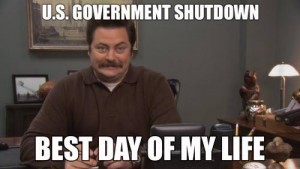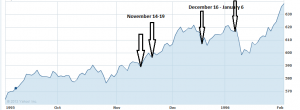October 2, 2013
By: Kelly Diamond, Publisher
The hyperbolic propaganda surrounding the recent “government shut-down” is rather glaring.
One need look no further than 1995 and 1996 to see that the markets barely flinch when the government “shuts down”.

But OOOOOH LORD you should hear some of the rhetoric being slung about recently! Harry Reid says, “We’re not going to go to conference with a gun to the head.” If I don’t comply with your Obamacare, how exactly does he plan to enforce it and compel me to do so? A gun to my head.
Another democratic congressman suggested that the Republicans leveraging a delay on Obamacare and the budget was EXTORTION! So? What the hell do you call that fine you charge companies that refuse to pay for health insurance for their employees? Comply or else… What is that called?
Outside the government, when I hear the term “shut-down” I think, “Going-out-of-business! Woo hoo! Hit them up for clearance items.” But by government standards, not having Mr. Ranger there to monitor the daily goings of Yogi Bear is a “shut-down”.
Oh the humanity.
I mean, when you think about it, you have an estimated 800,000 individuals on furlough… out of 4.1 MILLION employees. That means less than 20% of the federal workforce is chillin’ at home. Sadly, amongst that under 20% are NOT the 535 LEAST essential employees: Congress!
We had a very similar stand-off back in 1995 between Newt Gingrich and Bill Clinton. And it was over similar issues, but back then the list was longer because the dollar went further. Now we’re just holding our breath over the Affordable Care Act, whereas back then it was about the environment, education, and Medicare.
The private sector hardly felt the effects of that “shut down”. The quasi-private sector that relied on government spending like defense contracts and some tourism felt it a little more. And then there were the furloughed federal employees and citizens who relied on or were involved with government services were hit the hardest. “Health and welfare services for military veterans were curtailed; the Centers for Disease Control and Prevention stopped disease surveillance; new clinical research patients were not accepted at the National Institutes of Health; and toxic waste clean-up work at 609 sites was halted. Other impacts included: the closure of 368 National Park sites resulted in the loss of some seven million visitors; 200,000 applications for passports and 20,000 to 30,000 applications for visas by foreigners went unprocessed each day.”(source: Wikipedia)
“A shutdown won’t necessarily be disastrous, provided a resolution was found in a matter of days. IHS Global Insight, a research firm, estimates that a week-long shutdown would reduce gross domestic product by two-tenths of a percentage point,” writes Kevin Carmichael of Globe and Mail.
Take a look at this chart showing the trends of the S & P 500 during the time of the “shut-down”:

You see it? It’s the sweet, sweet sight of a rally in the market! We need the government so much that when it “shuts down” we prosper! But while the S&P had nothing but good news for the private sector during the last shut-down, here’s what it has to say about the U.S. Government (i.e. public sector) during THIS shut-down:
Standard & Poors: Shutdown And Debt Ceiling Debate Prove U.S. Not Worthy Of AAA Credit Rating
“The current impasse over the continuing resolution and the debt ceiling creates an atmosphere of uncertainty that could affect confidence, investment, and hiring in the U.S.”
It is a reassuring relief that the truly private sector couldn’t care less about whether the government shuts down or not. Interestingly enough, while the private sector is apathetic toward a shut-down, it does freeze up and freak out at the mere mention of government intervention. Just look at the small business response to Obamacare. I can almost hear the market’s sigh of relief toward the notion of government going away for a little while. And I can cut the angst with a knife when government puts it regulatory hat on ready to play dodge ball legislation to knock out healthy competition.
So while politicians would love to pat themselves on the shoulders for a job well done in “making the economy recover”, they are going to have a really tough time making that case as the shut-down’s lack of adverse effects on the private sector markets will only serve to prove how irrelevant they really are to its prosperity.
Bottom line, the last time this happened it didn’t affect private sector profits one bit, and it won’t likely affect them this time either. The banking industry is going to see business as usual, since the Fed isn’t going to shut down. After all, it’s TECHNICALLY privately held. The FDIC is funded by the banks themselves, so that’s not going anywhere.
In terms of lending, at worst, the Fed will keep the rates where they are until after the shut-down passes.
So when all is said and done, it would appear that the regulators, paper-pushers, and park rangers are the ones who need to worry. According to Stephen Gandel of Time Business, “despite what is thrown at the market – Middle East revolutions/civil wars, rising oil prices, earthquakes and nuclear disasters – the market seems to take it all in stride. And keep moving up. In all, the Dow Jones industrial average is up 7% this year.”
What about our debts? Well. What about them? They certainly aren’t going anywhere, but they don’t have a whole lot to do with whether we raise the debt ceiling again. Any person with experience living outside their parents’ basement knows that NOT being eligible for MORE credit isn’t the same as defaulting on your existing line of credit debt. They can and will still service the debt because while they might not have an extended line of credit yet, they do still have the same revenue source to service the debt which is: the U.S. Taxpayer.
The average citizen also understands that a reduction in spending power is not tantamount to an expenditure… a lesson yet to be learned by folks in government. When individuals don’t make as much one month as they did another, it’s not a cost. It’s a reduction in revenue. A cost implies that there was commerce: that something was purchased or gained and the cost was the price for that good or service. Simply making less money, therefore, isn’t a cost.
AND the average responsible citizen understands that when revenues go down, spending must go down, and priorities must be optimized.
I would think that if the stalemate were to continue, that we could just permanently eliminate the “non-essential” jobs of the federal government. It won’t continue because the whole “shut-down” thing is just posturing. And there is NO money being saved since the furloughed employees will likely receive back-pay as they did in the Clinton era shut-down.
In the end, this is all just politics. And all the fear-mongering is just propaganda to further the divide in the people and prey on their ignorance of how things really work in Congress and the Treasury. The real solution isn’t both sides coming to terms on extending our credit even further. The real solution is in anyone successfully putting forward a plan to reign in the spending.


They felt so secure in their (fake…parasitic) jobs from 2007 to 2012 buying all their new toys with smug looks on their faces at the expense of everyone else in the REAL private sector.
Do they still enjoy working for the gov /gov contractors now?
They should quit (right now) and produce because their masters have told them they are non-essential.
Bobby, I recently found myself on the email list of one of these worthless hacks with a “whitehouse.gov” address. I received the usual mass DIS-information nonsense talking about how Republicrats are protecting the middle class, etc. I emailed back: STOP “protecting” me NOW! The least you ever-bigger government, statist, worthless-hacks could do, AFTER the fucking we have been taking is shut down the goverment. Hell, I can’t even get you pieces of shit to NOT fund Boehner-care!
For some stange reason I haven’t received a response.
Laughing at “least you could do” comment! LOL That’s priceless! Thanks for reading and taking the time to comment!
Another home run, Kelly. Kudos!
It is a shame we can’t really shut it down, putting all federal bottom-feeders on the street. That would give the Sheep the confidence they need to wean themselves from government’s teat.
Thank you, Jim! I always appreciate you chiming in and taking the time to read.